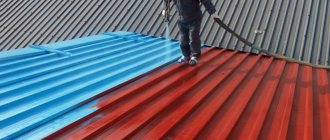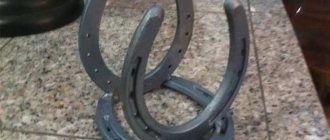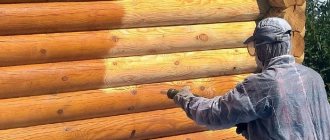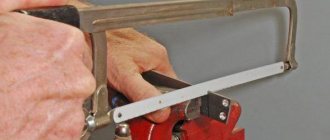Applying patina to metal and wood products
Patina is a special paint that allows you to give a metal or wooden surface an aged, noble look. The meaning of the word “patina” has nothing to do with paints. The term refers to a thin film that forms on a metal surface after prolonged interaction with oxygen.
The process of film formation on metal has been known since ancient times. Previously, this process was called bluing. However, bluing has a number of serious disadvantages:
- This is a complex technology and it is not easy to repeat it with your own hands;
- the cost of bluing is high;
- the process takes a lot of time.
Modern paints make it possible to paint a surface (not only metal, but also wood) much faster - within a few minutes. At the same time, the quality of the material is completely preserved.
Features of patination technology
The definition of “patina” originally characterized the appearance on products made of copper and its alloys of a thin film of oxides, which gave the item an “aged” appearance. Modern patination technology makes it possible to age wooden surfaces, furniture elements and products in general, which significantly increases their decorative value.
Industrial patination technology is quite complex, but there are simplified aging methods that, with available reagents and certain skills of an amateur chemist and restorer, will give objects an antique look.
In order not to spoil the furniture product, before patination it is necessary to test the chosen method on a piece of wood.
The simplest and safest way to age furniture is to rub dark wax into its surface. This gives it a natural appearance, associated not with careless care, but with time, contamination.
To increase the decorativeness and naturalness of aging, many restorers use ordinary paints that match the color, “diluting” them with bronze or aluminum powder (powder). All these materials can be found in construction and finishing accessories stores. In addition, special patination kits have recently appeared on sale, which include not only coloring and decorating compositions, but also the tools necessary to perform the operation.
On a note! In addition to metal powder, you will need sandpaper of varying abrasiveness, cotton or foam swabs, and for aging large wooden surfaces - a paint roller.
It should be borne in mind that home patination is essentially a conventional coloring, in which, instead of standard paints, special compounds are used that do not change the structure of the wood, actually aging it, but only give the product an antique look. This coating, in case of an unsuccessful experiment or if you don’t like the appearance, can be easily removed from the surface of the object without causing significant harm.
Most often, experiments on artificial aging are carried out in relation to furniture. To do this, you can use chairs, tables, chests of drawers, cabinets that have lost their visual appeal, and their design does not meet the requirements of the time.
From quite strong, functionally suitable furniture products, you can create the interior of a living space or kitchen in one of the retro styles. In addition to the applied tasks of increasing decorativeness, the restoration technology under consideration also pursues practical goals. The applied new paint layer will not only change the appearance of furniture items, but will also additionally protect the surface from adverse external influences.
Color solutions
The most common type of patina is copper oxide. The surface painted with this paint has a greenish appearance. On other metals, oxidation processes occur differently, so patina gives different colors, for example:
- on steel - ocher or yellow;
- on bronze and brass - brown;
- on silver - darkish gray.
In construction supermarkets you can buy patina in a variety of colors:
- like silver;
- under natural copper;
- under gold;
- green copper oxide.
These are the most common colors, however, paints with more exotic shades are also available. Such paints do not imitate any metal, but are an independent color scheme. Their use is usually associated only with the desire to give the surface an antique look.
As an example, the following colors can be given:
Application technology
The principles of patination of metal and wood are different. Powder (forge) patina is used for metal, and acrylic patina is used for wood.
Acrylic patina
This paint is almost never used on metal surfaces. The reason is poor adhesive properties. However, acrylic is perfect for painting wooden products, as it penetrates deeply into the pores of wood and emphasizes the beauty of its fibers and structure. Wood painted with acrylic patina takes on a noble appearance, its appearance is enriched with color transitions.
Note! It is not recommended to apply patina to furniture made in a modern style. Furniture painted this way will not look aesthetically pleasing.
Patina painting is often used for items made in the following styles:
The acrylic patina coating technology is called abrasion. Aging consists of first applying a layer of paint, which will act as a so-called substrate.
- Before painting, the surface is thoroughly but gently cleaned with a wire brush or coarse sandpaper. In this case, part of the surface is removed, and the structure of the tree becomes more obvious. You need to sand the wood in such a way that the movements are directed along the structure and only in one direction. This will show the texture without compromising the integrity of the wood.
- The next step is to apply a thick layer of acrylic patina. Next, you need to wait a few minutes until the material penetrates the wood. At the same time, you need to remember: the longer the pause, the darker the painted product will ultimately be.
- Excess paint is removed with a sponge or soft rag.
- After the paint has dried, you can make the color more saturated by applying an additional layer of paint material. You can also varnish the surface.
Patination
Nowadays, patination is actively used in the production and restoration of furniture, and both natural wood and the more common MDF panels can be aged. Furniture with a patina can look very rich without actually being expensive. Looking at such interior items, many people think that they see in front of them an ancient set that served some noble family for many years. But in fact, these cabinets were made at the factory just yesterday.
Furniture with patina can look very rich
Creamy caramel color scheme with bright splashes
The option with patinated furniture is suitable for those who really love antiquity, but cannot afford to spend fabulous money on good and high-quality antique furniture. Most often, the patina option is used to decorate rooms in the Provence style.
The mirror takes center stage here, but check out the stunning triple table
By the way, some owners of new furniture can age the interior items themselves by patination themselves at home. This technology is not complicated, but it is labor-intensive, but if you want, you can do everything yourself.
Scandinavian style patina
Patination technology involves applying acrylic or other paint to the furniture façade and then grouting it. After that, it is enough to coat the furniture with a special composition (varnish) so that it acquires a matte shine and remains protected from external influences.
Looking at this authentic bureau, it is unclear whether it has aged naturally or artificially
Boudoir bathroom in a country house
Powder patina
The first type of powder patina is considered to be silver. It is basically a powder that must be mixed with drying oil before use. How to properly breed silverfish, read in this material.
The color of blacksmith's paints is usually matte, and the patina gives the metal a noble shine. You can purchase powder material in the form of a finished product. For greater convenience when painting, the patina can be mixed with xylene or solvent.
Note! To paint metal products, it is recommended to purchase special material for blacksmithing.
Covering with blacksmith's patina is considered quite a difficult task in the absence of the necessary experience. To apply paint you will need something like a palette where you can smear the paint material.
- Clumps of patina should be placed on one side of the palette.
- Lightly wet the brushes in solvent or xylene. Then rub the paint until the brush is completely dry.
- Next, the paint is applied with careful strokes. The product should only be touched with the tip of the brush. The result should be an uneven layer of paint and something resembling scuff marks.
The process is very labor-intensive and time-consuming. Although the result is worth it - the product will take on a noble, aged appearance.
Due to inexperience, many people try to take as much patina as possible onto the brush to avoid rubbing it after a couple of strokes. However, it is strictly not recommended to do this, since in this case it will not be possible to achieve the desired result.
So, working with patina requires certain skills, so it is difficult for a beginner to count on quick success. It is recommended that you first use objects for patination that you don’t mind spoiling. After gaining experience, you can take on more responsible work.
Aging materials
Metallic-effect paints are most often used to paint forged metal. These are compositions in which the transparent varnish (binder) contains a large amount of non-ferrous metal powder (copper, bronze, aluminum, etc.).
As a result, a decorative coating is formed on the structures, reminiscent of the surfaces of silver, bronze or brass products.
Decorating allows you to get the effects of gilding, and with aging techniques, make it slightly worn.
Among modern materials:
- acrylic-based paints and varnishes, with gloss;
- polyurethane paint and varnish coatings (glossy and matte);
- nitro enamels;
- alkyd;
- three-component forging compounds with a rust transformer and primer (Zinga brands, etc.).
The main requirements for a dye when choosing are its purpose for working on metal, resistance to weather conditions and the content of anti-corrosion components. You can use both brush and spray formulations.
When purchasing patinas and paints for interior decoration, you must choose brands intended for interior use. A special mark or information on the packaging will help determine this. When finishing street structures, materials for external work are purchased. Three-component compositions are used without preliminary cleaning of the metal, removing only a loose layer of rust.
Patination or how to age metal (from here)
Patination is a technique for “aging” the surface of metal or wood, which is achieved by applying dyes based on various acids. As a result, the products acquire a special charm and the spirit of antiquity. Before carrying out manipulations, working surfaces are put in order, then treated with a special primer from a spray can, which allows the paint to better adhere to the surface. Patination of metal requires time and patience; we will look further at how to apply patina paint to the surface and what effect can be achieved.
What you need for work
The very meaning of the word “patina” has nothing to do with the dyeing process. It is of Italian origin and refers to the film that forms on metal after prolonged interaction with oxygen.
Initially, you had to wait a long time for the metal to oxidize itself, and the result was completely unpredictable; now this technique can be reproduced at home with your own hands using the following materials:
- patina of the color you like (in powder);
- liquid solvent;
- brush (size 2-3) or sponge;
- small plastic or glass trays (do not take metal ones, they can interact with the paint);
- metal product that you want to decorate.
Pay attention to safety precautions! Means for patination involve working with chemical oxidizing agents, solvents and require special care.
It is recommended not to work in confined spaces without respiratory protection. It is better to work in the fresh air, in rooms with good ventilation (with open windows, an exhaust fan on, a draft). If acid gets on the surface of the skin, immediately rinse under running water and then apply a paste of baking soda. If rashes, burns or any skin changes occur, consult a doctor immediately!
Patination colors
On different metal surfaces, completely different color schemes can be achieved by patination. The most common patina color is greenish, which is produced by the oxidation of copper. On other metal surfaces, the resulting shade may be completely different:
- Rich yellow or ocher color on steel surfaces.
- Chocolate brown on brass and bronze items.
- Dark gray on silver items.
The choice of dry patina for metal work is quite varied. Powder is sold in almost every hardware store. Most common colors:
- aged silver;
- natural or oxidized copper;
- red gold.
Brighter radical colors are also available, for example, blue, lilac, red, allowing you to achieve an original effect on the surface of various metals.
Tools and materials
Before work, you need to prepare all the necessary consumables - paint with an aging effect (with elements of bronze, silver, gilding), regular paintwork if you plan to repaint the product. Instead of paint, you can use wax, stain, shellac or mastic, depending on the chosen patination option.
Other process components that may be required:
- brushes of different sizes;
- roller (for large surfaces);
- sandpaper;
- primer;
- furniture or metal varnish;
- rags for removing excess paint;
- cotton and foam swabs.
Some craftsmen additionally purchase metal powder if the effect of the paint seems insufficient: it is usually used to artificially age metal fittings. There are also ready-made kits for sale for patination and antique restoration - “Patina Verde Green”, “Patina Gold”, “Idea Patina”. Most of the products included in the kits are suitable for various materials - plaster, metal, wood.
Surface preparation
Decorative application of patina requires careful preparation of the surface being treated; the metal must be perfectly smooth. There should be no signs of corrosion on it; it will not allow the surface to be well primed; the top layers will quickly bubble and peel off.
All burrs must be removed, chips and potholes must be filled and sanded with sandpaper (first coarse, then finer).
The prepared product is coated with a special primer (most conveniently, from a spray can), and then metal patina paint is applied to it.
Please note that the patina effect looks best on items painted with dark, especially black paint. The painted product must dry well, otherwise the patina will not adhere well and you will not achieve the desired effect.
Patina paint application technique
There are two ways to age metal: applying patina with a brush or sponge. By placing dissolved paint on the tip of a brush, you can achieve completely different textures, directional strokes and different depths of paint. Do not wet the brush before starting work; it must be dry; a wet brush will cause smudges and drops on the metal being processed.
Do not take a brush that is too large or small - the optimal bristle size is 2-3 cm. The sponge gives a “dusty” effect, but do not press it too hard, otherwise pores will be imprinted on the surface being treated.
Keep a napkin with solvent and some of the base paint with which the product is painted at the ready. Working with the patina should be virtually error-free. Repeatedly applying patina to metal in the same place gives an unsightly “flat” effect. When painting individual elements, be careful: if you accidentally “smeared” something nearby, simply paint over this area with background paint.
On video: applying patina to metal.
Patination of metal with oxidizing agents
Obtaining a patina on metal by immersing it in various chemical compounds is a labor-intensive method, which will result in the formation of a colored film (patina) on the surface of the metal. This type is much more durable, since the film does not wear off quickly under mechanical stress, like paint. If you want to feel creative and try to age metal using patination solutions, you will need special chemicals.
The surface to be treated should be prepared, as when working with paint, but not primed or painted, but degreased and bleached in an acid solution. You can carry out all the manipulations at home, create a masterpiece with your own hands or give new life to old objects.
How to do classic patination at home and get the colors you want? When patinaing brass, the most common colors sought are black or deep brown, olive, dark orange, or mouse gray. The brown color is achieved by immersing the metal in a solution of sodium thio-sulfite, popularly known as photofix.
An acid (sulfuric, hydrochloric, nitric) is first added to the prepared solution and the metal is lowered into it. Do not overexpose the product! The patina will appear very quickly. Work carefully! Use rubber gloves and take short breaks every 15-20 minutes.
Important! The coating is not very durable; it must be coated with varnish on top.
How to get other shades:
- To obtain an olive tint, brass products are immersed in a solution consisting of ammonia, water and chlorinated copper oxide (in a ratio of 4/5/2). Be very careful - the composition is toxic.
- A thick orange tint on brass will be given by a mixture of potassium sulfite, and a gray gray tint will be produced by liver of sulfur (a sintered mixture of sulfur 5 g in powder and potash).
- On copper, as on brass, the patina is very impressive. You can get a black tint on it (when immersed in sulfuric liver solution) and ancient blackness (if you mix 2-3 g of sulfuric liver, add the same amount of ordinary salt).
- Copper sulfate together with zinc chloride will give a blood-red patina.
- The luxurious blue color of steel will be given by a mixture of hyposulfite and acetic acid lead (150 g plus 50 g per 1 liter of water). The patina on steel appears both when immersed in a cold solution and when it boils (the shade will be more saturated).
- You can achieve a raven wing shade (“bluing”) by immersing the product in a chromium solution at the rate of 100 g per liter of water. The steel will acquire an amazing metallic glow with a deep, black-blue tint. After about 20 minutes, the steel will be covered with a film of an amazing blue-black hue.
- When bronze items are patinated, they acquire various shades of green and blue. To obtain a light green tint you will need 3 parts aluminum chloride, 1.5 5% vinegar and 5 copper salts. The exposure time of the desired shade on bronze is determined visually. The longer the exposure, the deeper and darker the resulting shade will be.
How to patina metals?
Patination methods
There are many ways to give a metal product an antique look. But all of them will involve the use of aggressive chemicals, and therefore they are implemented with great caution. The most famous and universal are patination methods using sulfur liver. The composition is made by mixing 1 measure of sulfur in powder form and 2 measures of potash, and also calcining them over fire. The result is liver of sulfur - a brown mass that can be stored in a glass jar.
- An aqueous solution should be prepared from the substance (the concentration will depend on the purpose) and it should be used to treat raised and protruding elements, as well as those that, over time, are subject to the greatest wear. The color can be obtained from light gold to blue and black on silver as well as copper.
- An aqueous solution of 1 measure of copper sulfate and 1 measure of zinc chloride makes it possible to obtain an aging effect of a brown or red tint.
- A black film appears when exposed to ammonium sulphide. But there are difficulties here too - the solution has a strong aroma, so patination should be carried out in a fume hood.
- Bituminous patina in finished form can help out those who do not want to make mixtures themselves. The solution is made on the basis of an organic solvent, and after patination, oil treatment is carried out. The color of the plaque will be light brown. The mixture can be used on gold products if you want to give them an antique look.
We will separately consider the decorative type of patination.
Decorative type of patina
Here the entire patination process is reduced to painting the relief areas of a wooden or metal product. An acrylic patina is used for this, which dissolves in water. It is applied with a brush or sponge to protruding areas, and then shaded.
Its advantage over acrylic paint and varnish is that the composition dries less quickly and makes it possible to create a feeling of naturalness. Acrylic patina can be applied to both wood and metal. The colors are usually close to the natural range - brown, light yellow, but probably the most popular color is metallic, in particular silver and gold plating. Wax, oil, and other types of compositions are also used.
They are not so widespread because they are more difficult to apply. As a rule, before patination, metal products are painted rather than simply primed. And if gold-type patination is chosen, then the preferred type of base paint is dark. Pieces of furniture made of wood are painted if they want to make the patina as contrasting as possible - for example, to obtain the effect of gilding on an oak surface. Or in the case when painting surfaces is part of the design - for example, a set in blue in country style and patina, as shown in the photo.
What is patination and how to apply patina yourself
Shiny kitchen fronts, without a single scratch or stain, look good in a modern minimalist, techno or hi-tech interior. But where authenticity is primarily required from the material and objects, patinated facades will be much more appropriate.
Doing this naturally takes too long, but resorting to imitation with your own hands is quite possible.
Patination of wood
This process refers to a method of aging wood in order to visually give it age. The technique is actively used in classic and rustic kitchen interiors, since in these cases it is assumed that furniture and other household items have been in use for a very long time.
The technology of the methods is different, but the goal is the same - to give wood or wood material a coating that forms on the solid wood during a long period of use. Moreover, this coating occurs when the furniture is cared for, and not just used, and therefore is so highly valued from an aesthetic point of view. At home, reproducing patina on wood or metal is not that difficult. Our master class offers many options that can actually be done with your own hands.
You can use wax, bitumen, and acrylic patina - depending on the future type of the product, your own skill and the nature of the material. It is worth immediately noting that different methods are usually used to patina metal and wood, although there are exceptions.
- Stain is the most common composition for giving wood a darker, noble shade. The stain is combined with preliminary brushing (removing soft wood fibers) and treatment with shellac primer or antique wax. The method is perfect for doing at home, but limits the choice to a natural range of colors: the colors of silver, gold, and brass are not allowed here. For MDF and chipboard boards, any master class does not allow the use of this method.
- Bituminous patina - it can be applied with a regular sponge and washed with white alcohol. The bituminous composition is easily absorbed into the pores, revealing the wood structure and aging the wood. The result must be sealed with varnish, preferably shellac. This method is not suitable for patination on metal.
- Acrylic patina is a universal product and is suitable for processing wood, metal, and plaster. Acrylic patina paint can have any color, including the fashionable shade of silver and gold. It is applied both to the entire surface - smooth facades, and to threads or convexities. Acrylic paint is most often combined to provide a contrast between a dark natural color and an “aged” one: for example, oak and gold, white oak and silver, walnut and red gold, and so on.
Acrylic paint can be mixed and applied layer by layer, creating very complex visual effects: appropriate recommendations can always be obtained from a master class on the forums. In addition, acrylic paint can be perfectly combined with decoupage, varnishing, painting and other methods of decoration.
- Wax patina provides not only the effect of antiquity, but also the most beautiful tints of color, including metal ones - silver, brass, bronze. Moreover, this effect is obtained on wood. The wax patina is ideal for highlighting carvings, cures slowly and is very convenient for any DIY project. Any master class recommends using a wax composition on carved dining room furniture.
- Shellac varnish itself creates a yellowish or reddish-brown tint depending on the number of layers. Sometimes this is enough to create an aging effect, especially in combination with decoupage. However, almost any master class suggests using shellac varnish as a finishing or intermediate coating not only for decoupage, but also for painting.
- Oil patina - any master class recommends using the composition for both wood and metal. Its properties resemble wax and also hardens slowly. It cannot be used in the classical decoupage technique, since the oil patina dissolves the paper.
Natural and artificial patina
Any type of metal other than platinum and gold reacts to some extent with moisture and oxygen in the air. In certain cases, the effect manifests itself extremely quickly - for example, rusting of iron, but in other cases the process can last for many years, as is the case with green patina on copper, silver patina, that is, blackening, etc.
Oddly enough, the presence of this coating, if the coating does not affect the characteristics of the product and does not destroy it, and not only cannot be destroyed, is even welcome. It is the noble touch due to color transitions that emphasizes the beauty of forging and carving, the volumetric texture or indicates the age of objects, which will involuntarily transfer pieces of furniture for the living room or other products into the category of rare (at least antique).
As a result, an artificial patina will appear. It is obtained by other methods.
Natural patina is the result of metal oxidation in the atmosphere. It can be divided into wild and noble. It is divided into wild and noble. The second has a dense structure and protects the metal from corrosion (for example, a green patina on copper), and the second is loose, so it will not protect the metal from moisture. Such film must be disposed of.- An artificially made patina is formed much more quickly due to certain chemical reactions. Such coatings are not as durable and more porous than a noble film, but they still protect the metal.
- A group of decorative patinas can also be distinguished. This is a type of imitation that is created using ordinary paints and stains - for example, acrylic. The color in this case can be absolutely anything - from light golden to black and even white, and can also include shades that are not at all typical of natural materials.
Next, we will consider the features of wood processing.
Applying patina to wood
This process is simple and can be done at home. However, there is a difference in the processing and preparation of wood, metal and MDF and chipboard. The latter have a uniform structure, unlike wood, and therefore their painting, aging, decoupage and all other techniques have their own characteristics.
Preparatory stage
Wood and wood-fiber materials in kitchen furniture are not used in their original form. The furniture surface is protected by varnish, acrylic or PVC film, lamination, etc. Depending on the nature of this coating, you have to choose a paint with a patina and a method. The patination master class takes into account all the features of materials.
- Wood for patina, tinting and varnishing is treated with a wire brush or coarse sandpaper. This method is called brushing. Its essence comes down to removing soft fibers and exposing the structure from harder ones. Brushing reproduces the natural aging process, but in an accelerated form. After removing the fibers, the surface is cleaned and treated with a degreasing compound.
The wood is not brushed before staining and painting, but only cleaned. Sanding is only needed to remove the varnish, if any.
Veneered MDF board can, in principle, be processed with sandpaper to give a scuffed effect, especially using the decoupage technique. But in practice, another method is preferable.
- A layer of barrier primer is applied to the MDF or chipboard board - this composition ensures adhesion of the top layer of MDF and chipboard to the primer, patina - gold, dark, silver color or paint. After drying, apply a second layer - polyurethane primer. It forms a base that will imitate scuffs or cracks. This second layer on the MDF board is then sanded with sandpaper to replicate the natural grain of the old wood.
The paints and compositions for patina for wood and MDF are the same. As for metal, in a furniture set it is represented only by fittings. Some of the compositions can be used for painting metal.
Patination of furniture using stain
This is the most accessible way to do it yourself; the master class lessons will tell you how to do it correctly. The effect is as close as possible to natural, which is best suited for classic styles. The color of the kitchen furniture will be darker, which needs to be taken into account.
- A layer of water-based stain is applied to the entire surface of the façade. The color of metal - brass, silver, gold - cannot be obtained here, but you can give cheap wood the appearance of expensive wood - oak, beech, walnut.
- Using a soft sponge, part of the composition is erased so as to create the effect of antiquity - from the middle areas, while the border, milling elements, and cracks remain untouched. You can use a sponge or brush. After drying, apply a second layer of stain, but always on a different base - white alcohol, for example.
- After drying, the surface is covered with shellac varnish with your own hands. If you want to enhance the effect of antiquity, antique wax is also rubbed into the wood.
Details
Patination of wood and types of products
Plaque on wood most often does not mean anything good, because it appears when it is affected by rot or fungus. But on wood with high density and hardness, insensitive to water - for example, oak, a dark or white patina will become a real indication of antiquity. Furniture in an ordinary living room is often subjected to an artificial type of patination, because it is extremely difficult to obtain a natural type of patina. To improve the effect, mechanical and chemical methods should be combined. Several compounds are used for wood, and they are bought in construction markets.
- Thick patina - sold in the form of a paste, and is usually two-component. Typically, light brown, gold or reddish shades are obtained this way. For the gilding effect, the basis will be the natural color of the wood - for example, oak.
- Liquid - in fact, this is a special varnish composition that gives the wood a light yellow or even golden hue, which is inherent in ancient ash or oak.
- Faceted varnish composition - it is not exactly a patina, but rather an antique effect based on cracking. After drying, the varnish will begin to show the finest cracks, as happens on very old wood.
Types of coatings can be combined to obtain other, more interesting effects.
Patination methods
How to apply patina paint? The technology is almost the same for all methods, and only differs in the number of layers of paint or varnish composition.
- The first stage after cleansing and degreasing is brushing. Processing with a metal brush, or at worst with a chisel and nails, comes down to removing soft fibers on the wood surface, which, in fact, will happen over time.
- Next, pieces of furniture for the kitchen or living room should be treated with a white primer and sanded. White is most often used under light and gray tones. But if they want to make the basis of the effect contrasting, then use a transparent primer.
- Apply a coat of varnish and dry.
- Next, apply the patination composition and, after drying for a short time, remove the excess so that the composition remains in the deep pores.
- Cover everything again with a dark patina and again remove excess to the extent that you want to maintain the contrast between the fibers (dark and light). Next, coat the furniture twice with a simple transparent varnish.
Now let's talk about using the product for metals.
Patina on metal
Metal products in the interior of a living room or bedroom are not so common and are usually decorative and small in size - sconces, chandeliers, stands, candlesticks and the rest. Despite the fact that the new product has a bright shine and a beautiful color, there are quite a lot of people who want to give them a less modern look. And since it takes a long time to wait until this effect is achieved naturally, they resort to the use of chemicals.
Types of patina
The shades and varieties of film on different types of metals under different conditions differ and are very noticeable.
- The aging effect on the surface of silver looks more attractive. The metal is quite inert, and the film usually appears when reacting with sulfur, creating shades with tints from light yellow to turquoise and crimson. A black patina appears when exposed to chlorides and amino acids. The wild variety of this genus is not the most beautiful - the film is rough, and it also begins to protrude above the surface. But the blackening of silver surfaces helps give the product a rare elegance.
Gold is a noble metal that practically does not react. But if the alloy contains nickel or copper, light brown or even orange spots may appear after a while. Much more designers are attracted to the imitation of a patinated surface based on a gold color. This effect is purely decorative and is created with gold-colored paint, and at the same time a patina can be created on wood and metal - for example, on oak wood.- Usually in the living room you come across bronze and copper products, and sometimes with iron, if we are talking about a loft-style living room. On a copper surface, blue and green films are due to the deposition of copper acetate and chlorides, while black films are due to the formation of sulfite or oxide. Red patina is also formed by chlorine salts, but is usually formed artificially. A brown patina begins to appear when exposed to ammonium salts. For copper, almost all types of deposits are relatively safe, which will make forged copper products an excellent decor for the living room.
- But for bronze, blue and green coatings are dangerous. The decorative patina paint for the alloy is only a black film. They are achieved artificially through bluing - oil treatment and calcination in copper filings.
Applying patina or patination. Compositions and application.
Patina
is a greenish-brown coating formed on objects made of copper and bronze as a result of oxidation under the influence of the environment. In a broader sense, patina refers to signs of aging on any objects made from any materials.
Patination in decoration is an imitation of darkening of the surface, which in its natural form appears as color changes after a long period of time, oxidation and frequent contact with hands. Patina can be dark, colored, metallic, white (liming).
The patination composition is applied to the edges, corners of the object, or vice versa, into the recesses of the relief parts.
Features of the patination technique
Initially, the concept of “patina” characterized only a darkened coating on copper products - over time, a film of oxides gave the metal an “aged” appearance. Later, the word began to be used to reflect the vintage look of other materials - wood, bronze, iron, plaster. Recently, houses, cottages and even city apartments have been decorated in an antique style. Artificially aged wooden furniture with “antique” fittings looks especially stylish.
Modern technologies help to age – patina – any materials. Industrial methods are difficult for home use, but there are various patination compounds on sale that allow you to increase the age of materials in a simpler way. They help imitate the natural color changes of products by applying special coatings. When patination, conventional paints are replaced with specialized compounds without affecting the internal structure of wood or other material.
The simplest aging method is to rub wax into the corners, raised protrusions, and edges of the product. The result is an effect of “age-related” changes in the surface, ideal for decorating a room in a retro style. Such a coating also has a practical function - it protects the base from external influences and imparts water-repellent properties. If the result is unsatisfactory, the home patina can always be removed without significant harm to the product.











